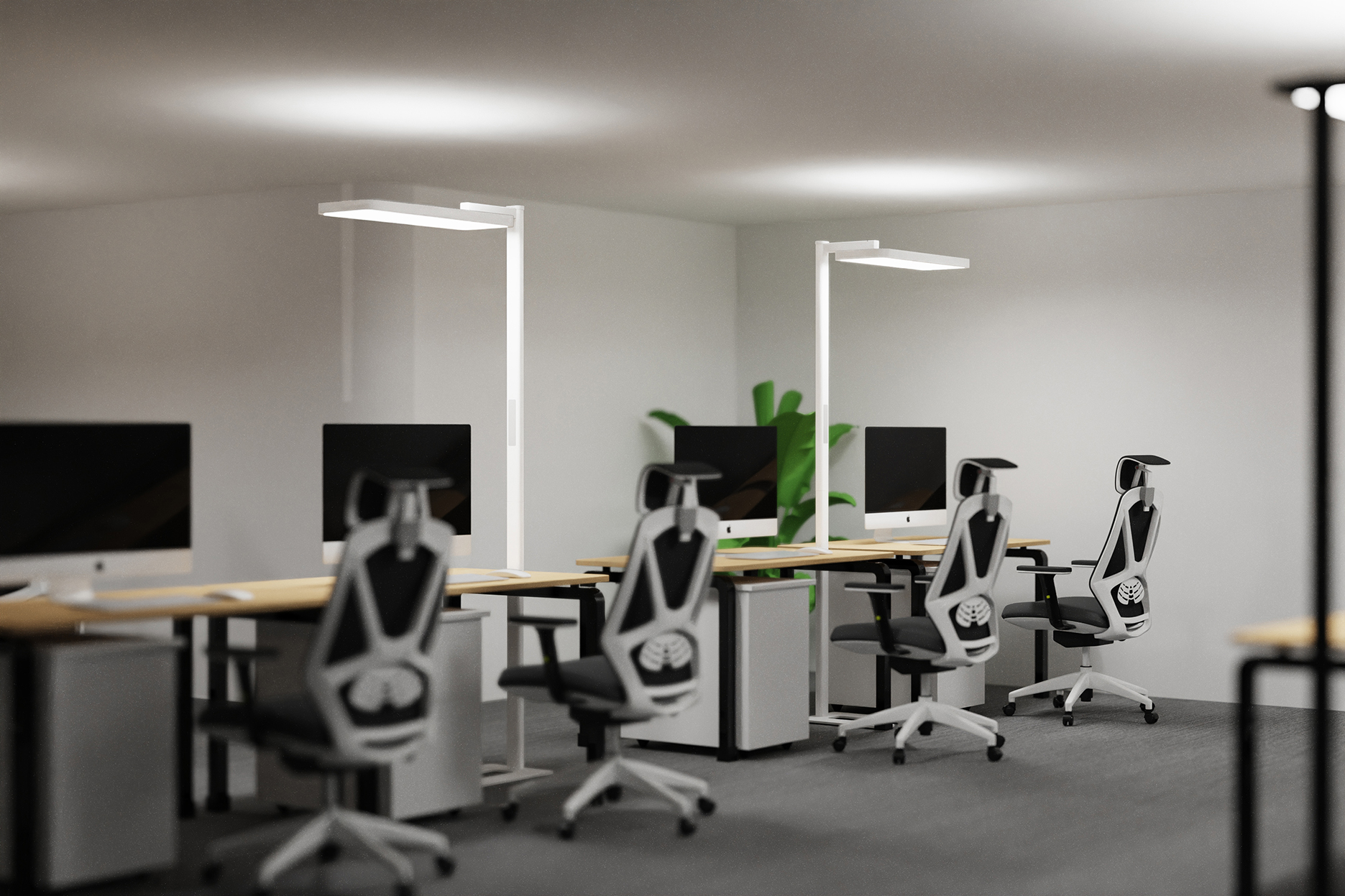1. Introduction
Art floor lamps have emerged as captivating elements in interior design, seamlessly blending the practicality of illumination with the creativity and expression of art. These lamps are not just sources of light; they are statement pieces that can transform a room, adding character, charm, and a touch of sophistication. In an era where personalization and unique design are highly valued, art floor lamps offer a way to infuse a space with individuality. This comprehensive exploration will delve into the various aspects of art floor lamps, including their design elements, different styles, benefits, applications, and considerations for selection.
2. Design Elements of Art Floor Lamps
2.1 Sculptural Bases
One of the most defining features of art floor lamps is their sculptural bases. These bases are often crafted with meticulous attention to detail, taking on a wide range of forms. Some bases are inspired by nature, with designs that mimic the curves of tree trunks, the elegance of flower stems, or the organic shapes of rocks. For example, a lamp base might be shaped like a twisted tree branch, with realistic textures and colors that give it a lifelike appearance. This not only provides a stable foundation for the lamp but also serves as a work of art in itself.
Other bases may have more geometric or abstract designs. Geometric bases can feature clean lines, angles, and shapes such as triangles, circles, and squares, combined in innovative ways to create a modern and visually striking look. Abstract bases, on the other hand, can be more free - form, with fluid curves and unexpected contours that challenge traditional notions of lamp design. These bases are often made from materials like metal, which can be bent, welded, and shaped into intricate forms. Metal bases can be finished in various ways, such as brushed nickel for a sleek, contemporary look or antique bronze for a more classic and rustic feel.
2.2 Creative Lamp Shades
The lamp shades of art floor lamps are equally creative and diverse. They play a crucial role in diffusing and directing the light, while also contributing to the overall aesthetic of the lamp. Fabric lamp shades are a popular choice, as they can be made from a variety of materials and come in different patterns and colors. Some fabric shades are hand - printed with unique designs, such as floral motifs, geometric patterns, or even custom - made artworks. These prints can add a touch of personality and charm to the lamp.
Lampshades can also be made from glass, which offers a different set of possibilities. Stained glass lamp shades, for instance, are known for their vibrant colors and intricate designs. They are often crafted using traditional stained - glass techniques, where pieces of colored glass are cut, assembled, and soldered together. When lit, the light shining through a stained - glass lampshade creates a beautiful, multi - colored glow that can be both eye - catching and soothing. Frosted glass lamp shades, on the other hand, provide a more even and diffused light, with a soft, milky appearance. They can be etched or engraved with patterns to add a decorative element.
2.3 Incorporation of Unusual Materials
Art floor lamps often push the boundaries by incorporating unusual materials. Recycled materials are increasingly being used in lamp design, not only for their environmental sustainability but also for the unique textures and stories they bring. For example, a lamp might be made with a base constructed from reclaimed wood, which has a natural patina and character that cannot be replicated with new wood. The wood could be from an old barn, a demolished building, or a discarded furniture piece.
Another unusual material is concrete. Concrete can be molded into various shapes and finishes, giving the lamp a modern and industrial look. It can be left in its raw, rough - textured state for a more rustic feel or polished to a smooth, sleek finish for a contemporary aesthetic. Some art floor lamps also incorporate materials like leather, rope, or even recycled metal objects such as gears or pipes. These materials add an element of surprise and interest to the lamp, making it truly stand out as a work of art.
3. Styles of Art Floor Lamps
3.1 Modern Art - Inspired Floor Lamps
Modern art - inspired floor lamps draw on the principles of modern art movements such as minimalism, cubism, and futurism. Minimalist art floor lamps typically feature simple, clean lines and a limited color palette. They often have a single, unadorned pole and a basic geometric lampshade, like a simple cylinder or a square. The focus is on functionality and a sleek, uncluttered look. Cubist - inspired lamps, on the other hand, break down forms into geometric planes and angles. The base and lampshade may be composed of multiple, interlocking geometric shapes, creating a sense of depth and dimensionality. Futurist - inspired art floor lamps often incorporate elements that suggest movement and speed, such as streamlined forms, metallic finishes, and dynamic angles. These lamps are designed to evoke the energy and innovation of the modern age.
3.2 Traditional and Classic - Style Art Floor Lamps
Traditional and classic - style art floor lamps take inspiration from historical design periods such as Victorian, Edwardian, and Art Nouveau. Victorian - style lamps often have ornate bases, with intricate carvings, filigree work, and decorative elements. The lamp shades may be made of rich, heavy fabrics with elaborate patterns. Edwardian - style lamps are known for their elegance and simplicity, with more refined and understated designs compared to Victorian lamps. They often feature brass or bronze finishes and delicate glass lamp shades. Art Nouveau - inspired art floor lamps are characterized by their organic, flowing forms, inspired by nature. The bases and lamp shades may have curves that resemble the shapes of vines, flowers, or leaves, and they are often made from materials like wrought iron and stained glass.
3.3 Bohemian and Eclectic Art Floor Lamps
Bohemian and eclectic art floor lamps embrace a free - spirited and diverse approach to design. Bohemian - style lamps often incorporate a mix of colors, patterns, and materials. They may have brightly colored fabric lamp shades with ethnic - inspired prints, such as Moroccan or Indian patterns. The bases could be made from a combination of materials like wood, metal, and rattan. These lamps create a warm, inviting, and laid - back atmosphere. Eclectic art floor lamps, on the other hand, combine elements from different styles, periods, and cultures. They might have a modern - style base with a traditional - style lampshade, or incorporate elements from Asian, African, and European design. This creates a unique and personalized look that reflects the owner's individuality and love for variety.
4. Benefits of Art Floor Lamps
4.1 Aesthetic Enhancement
The primary benefit of art floor lamps is their ability to enhance the aesthetic appeal of a space. These lamps can serve as focal points, drawing the eye and adding visual interest to a room. Whether it's a modern, minimalist lamp in a contemporary living room or a traditional, ornate lamp in a classic - style study, art floor lamps can elevate the overall design of the space. They can also be used to complement existing decor. For example, a lamp with a nature - inspired base can blend in seamlessly with a room decorated in a rustic or earthy style, while a lamp with a bold, geometric design can add a touch of modernity to a more traditional space.
4.2 Personalization
Art floor lamps offer a high level of personalization. With their wide range of styles, materials, and designs, individuals can choose a lamp that reflects their personality, taste, and interests. For someone who loves nature, a lamp with a base shaped like a tree or a flower can be a perfect choice. For those with a passion for art and design, a lamp inspired by a particular art movement can be a statement of their creativity. This personalization allows homeowners and interior designers to create unique and one - of - a - kind spaces.
4.3 Functional Illumination
In addition to their aesthetic value, art floor lamps also provide functional illumination. Depending on the design, they can be used for task lighting, such as reading or working, or for ambient lighting, creating a warm and inviting atmosphere in a room. Some art floor lamps come with adjustable features, such as dimming capabilities or adjustable lamp heads, which further enhance their functionality. For example, a lamp with a dimming feature can be adjusted to create a more intimate atmosphere for a dinner party or a brighter light for a reading session.
5. Applications of Art Floor Lamps
5.1 Residential Settings
In residential settings, art floor lamps have a wide range of applications. In living rooms, they can be placed next to a favorite reading chair, providing both a source of light for reading and a decorative element. A statement - making art floor lamp in the corner of a living room can also add a touch of elegance and style, making the room more inviting. In bedrooms, art floor lamps can be used as bedside lamps, creating a cozy and relaxing atmosphere. They can also be used to highlight a piece of art or a decorative object in the room. In home offices, art floor lamps can provide task lighting while adding a touch of creativity to the workspace.
5.2 Commercial Spaces
Art floor lamps are also finding their way into commercial spaces. In hotels, they can be used in lobbies, guest rooms, and restaurants to create a unique and memorable atmosphere. A well - chosen art floor lamp in a hotel lobby can make a strong first impression on guests. In restaurants, art floor lamps can be used to create a more intimate and romantic dining environment. In retail stores, art floor lamps can be used to highlight products, drawing customers' attention and making the shopping experience more engaging. In art galleries and museums, art floor lamps can be used to enhance the display of artworks, providing focused lighting and adding to the overall aesthetic of the exhibition space.
5.3 Public Spaces
In public spaces, art floor lamps can play a role in enhancing the ambiance and functionality. In libraries, art floor lamps can be placed at reading tables, providing both light for reading and a touch of style. In parks and outdoor seating areas, weather - resistant art floor lamps can be used to provide illumination during the evening hours, creating a more inviting and safe environment. In cafes and coffee shops, art floor lamps can contribute to the overall atmosphere, whether it's a modern, hipster - style cafe or a more traditional, cozy coffee shop.
6. Considerations for Choosing Art Floor Lamps
6.1 Style Compatibility
The first consideration when choosing an art floor lamp is style compatibility with the existing decor. Whether the space has a modern, traditional, bohemian, or eclectic style, the lamp should blend in or complement the overall aesthetic. For a modern - style room, a lamp with clean lines and a contemporary design would be suitable, while a traditional - style room would benefit from a lamp with classic, ornate features. It's important to consider the color palette, materials, and overall design elements of the room and choose a lamp that enhances rather than clashes with them.
6.2 Functionality Requirements
Functionality is another important factor. Consider the purpose for which the lamp will be used. If it's for task lighting, such as reading or working, a lamp with a focused light source and adjustable features may be necessary. For ambient lighting, a lamp with a diffusing lampshade and perhaps dimming capabilities would be more appropriate. Also, think about the height of the lamp and whether it will provide the right amount of light at the desired level. A taller lamp may be more suitable for a large, open - plan room, while a shorter lamp could be better for a smaller, more intimate space.
6.3 Quality and Durability
Quality and durability should not be overlooked. Art floor lamps can vary widely in quality, depending on the materials used and the craftsmanship involved. Look for lamps made from high - quality materials that are built to last. Metal bases should be sturdy and well - constructed, and lamp shades should be made from durable materials that can withstand regular use. Check for any signs of poor craftsmanship, such as loose joints, uneven finishes, or flimsy construction. A higher - quality lamp may be more expensive upfront but will save money in the long run by not needing frequent replacements.
6.4 Budget Constraints
Budget is an important consideration. Art floor lamps can range in price from relatively inexpensive mass - produced models to high - end, custom - made pieces. Set a budget before starting the search and look for lamps that offer the best combination of style, functionality, and quality within that budget. It's possible to find unique and well - designed art floor lamps at different price points, so with some research, you can find a lamp that meets your needs without breaking the bank.
7. Maintenance and Care of Art Floor Lamps
7.1 Cleaning
Regular cleaning is essential to keep art floor lamps looking their best. The lamp shade should be cleaned regularly to remove dust and dirt, which can affect the light output and the appearance of the lamp. Fabric lamp shades can be gently vacuumed using a soft brush attachment. For stained fabric shades, spot - cleaning with a mild detergent may be necessary. Glass lamp shades can be wiped clean with a damp cloth. If the glass is stained or dirty, a glass cleaner can be used. The base of the lamp should also be cleaned periodically. Metal bases can be polished with a suitable metal cleaner to maintain their shine, while wooden bases can be dusted and, if necessary, treated with a wood polish to keep them looking their best.
7.2 Bulb Replacement
When it comes to bulb replacement, it's important to use the correct type of bulb recommended by the manufacturer. Different art floor lamps may require different bulbs, such as incandescent, halogen, LED, or fluorescent. Follow the instructions in the lamp's user manual for safe and proper bulb replacement. In some cases, you may need to use a ladder or other tools to reach the bulb, so take appropriate safety precautions. It's also a good idea to keep spare bulbs on hand, especially for high - use lamps, to minimize any disruption in lighting.
7.3 Safety Checks
Periodically conduct safety checks on art floor lamps. Check the stability of the lamp, ensuring that the base is firmly on the ground and that the lamp does not wobble. Inspect the cord for any signs of fraying, cracking, or damage. If the cord is damaged, do not use the lamp and replace the cord as soon as possible. Also, check the electrical connections to make sure they are secure. If the lamp has any adjustable parts, make sure that they are working properly and that the joints are tight.
8. Conclusion
Art floor lamps are a remarkable fusion of art and functionality. They offer a unique way to illuminate spaces while adding a touch of creativity, personality, and style. Whether in a residential, commercial, or public setting, these lamps can transform the ambiance and make a lasting impression. By carefully considering factors such as style compatibility, functionality, quality, and budget, individuals can select the perfect art floor lamp to meet their specific needs. With proper maintenance and care, art floor lamps can continue to be a source of beauty and illumination for years to come, enhancing the aesthetic and practical aspects of any space they inhabit.



